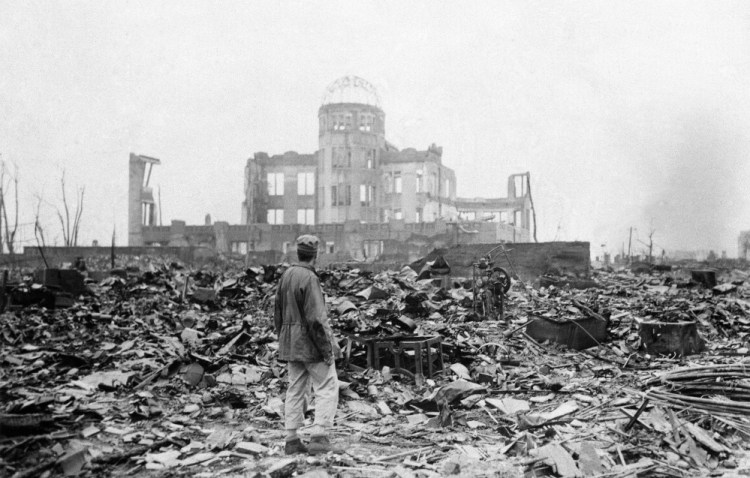My father – New Yorker Charlie Watson – nearly fought two wars during his combat time in World War II.
The first was in Italy, where he and his 91st Army Division methodically chased the Germans up the Italian boot for two years in the days just before VE Day in the spring of 1945.
But just as he was preparing for a new life and a new fiancée back in the U.S., he learned he was to be part of what would be the biggest single engagement of the Pacific campaign, a massive million-man assault of the Japanese mainland.
My dad was a humble soldier, decorated with the Bronze Star, focused on the task at hand. In 1986, I did a video interview with him and he casually mentioned Japan and his possible fate. No big deal, he suggested.
It was called Operation Downfall. But it never happened, as it was rendered unnecessary by the atomic bombings of Hiroshima and Nagasaki in late summer 1945, much to the surprise of the world.
It was to be epic in scope. Forty percent of the U.S. soldiers still in uniform in 1945 would be deployed. More than 180,000 paratroopers would join the landing craft. Fear of kamikaze attacks and poison gas drove military planners to drastic decisions.
It was all part of the peculiar final days of the war. Secretly, the Manhattan Project had been developed, and atomic tests conducted. The worrisome Soviets entered the theater as a full combatant on the Allied side against Japan. Conventional fire-bombing of cities was stepped up in an effort to bring Emperor Hirohito to his knees.
The United States desperately wanted the war over, to bring all its troops home. But the Japanese wouldn’t budge, fighting with ferocity and skill.
HISTORY OF THE THEATER
The United States had invaded Japan before – years earlier, in 1853, when Commodore Matthew Perry led his four sailing ships into the harbor at Tokyo Bay, seeking to re-establish regular trade and discourse between that country and the West after a hiatus of over 200 years.
Over the years the U.S. encouraged and condoned Japan’s muscle-building and development as the strongest power in the region. Ironically, Japan later flexed those muscles, vanquishing Russia in the Russo-Japanese War of 1905, and later initiating full-scale hostilities throughout Asia by invading China in the 1930s and then the U.S. Pacific Fleet at Pearl Harbor on Dec. 7, 1941.
War raged around the world. In Europe, Hitler commanded a continent. In the Pacific, Japan’s legions gobbled up a land mass and thousands of miles of islands. Our Asian war (1942-45) conjurs up images of the arduous and bloody island-hopping moves geared to roll back and to destroy Japan. Midway. Guadalcanal. The Philippines. Burma. Guam. Coral Sea. New Guinea. Finally, Iwo Jima and Okinawa, where 94 percent of 117,000 Japanese defenders perished.
The ending months in the Pacific were horrific. After losing eight battleships and most of its Pacific Fleet to Japanese attackers in late 1941, the United States saw 111,000 dead and 253,000 wounded in the Pacific Theater by the summer of 1945. U.S. forces vaulted closer to Japan. Numbers of American dead mounted in ferocious fighting. Local newspapers in Maine filled with combat obituaries.
OPERATION ABANDONED
Historian James Martin Davis wrote in the Omaha World-Herald that Operation Downfall “might have been one of the most horrible campaigns in the history of man.”
Set to start in November 1945, Downfall was intended to capture the southern third of the southernmost main Japanese island, Kyushu, with the island of Okinawa to be used for staging.
If the campaign had taken place, it would have been the largest amphibious operation in history, dwarfing the European landing at Normandy. The war could be extended into 1947, some planners said.
The Japanese planned an all-out defense of Kyushu. Casualty predictions varied widely. One estimate predicted 6 million Japanese dead. Hundreds of thousands of Americans would be in peril.
So, Dad, 24 at the time, went about his business, visiting New Hampshire, courting Claire St. Cyr, but putting off marriage plans until 1946. He knew things might be tentative.
And there were his brothers – John, 21, and George, 19. Both were already fighting in the Pacific Theater in those uneasy times.
Downfall was abandoned when Japan surrendered following Hiroshima and Nagasaki. The atomic bombs ended it all. Suddenly the war was over.
Send questions/comments to the editors.



Comments are no longer available on this story